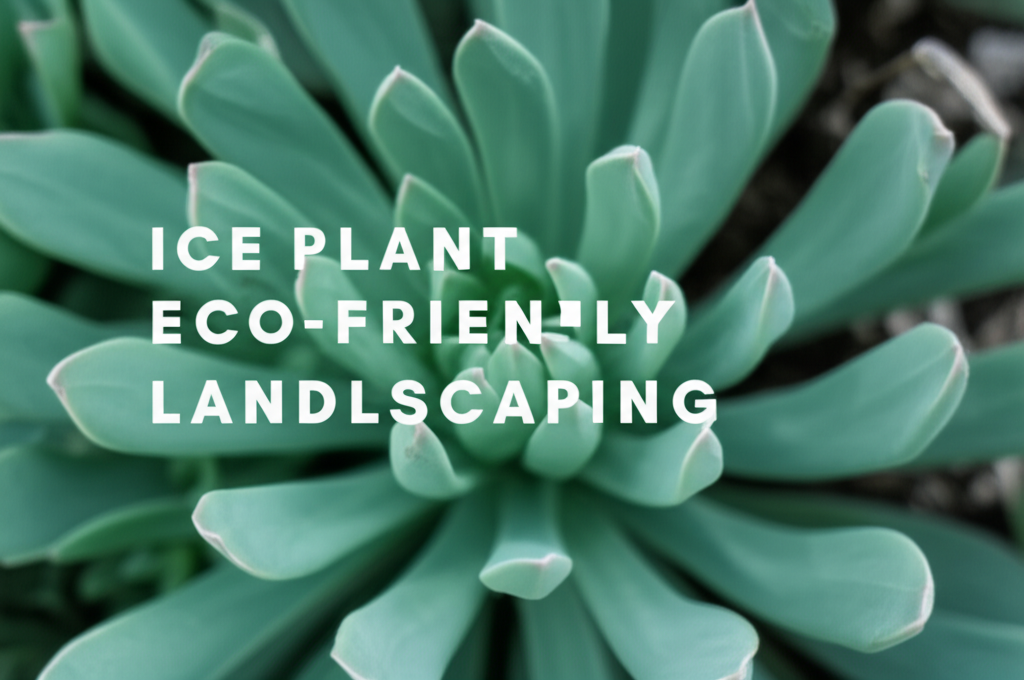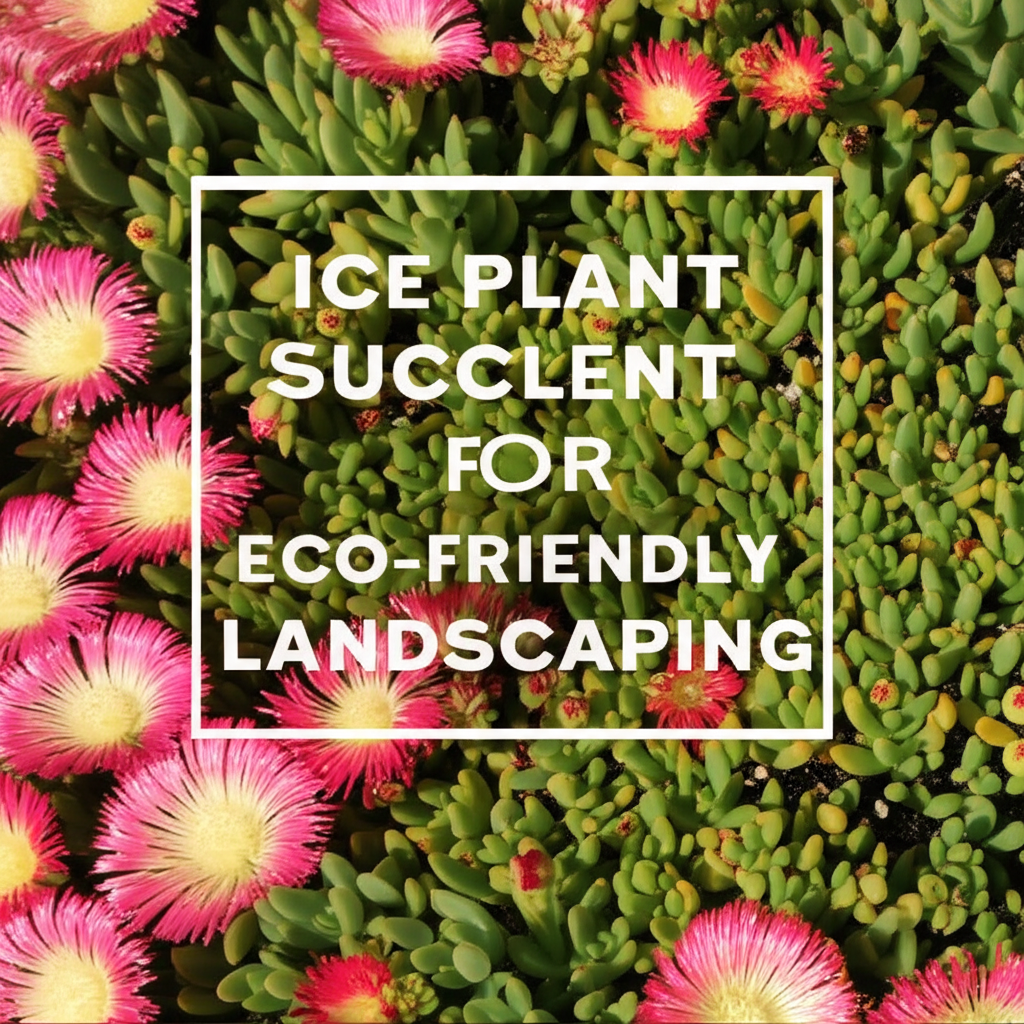Introduction: Embracing the Ice Plant for a Greener Tomorrow
In the quest for sustainable and low-maintenance gardening, the humble ice plant succulent emerges as a true champion. Often overlooked amidst more flamboyant flora, these resilient plants offer a wealth of benefits for the environmentally conscious landscaper. Their striking beauty, coupled with remarkable drought tolerance and adaptability, makes them an ideal choice for creating vibrant, water-wise gardens that thrive even in challenging conditions. This article delves into the multifaceted advantages of incorporating ice plant succulents into eco-friendly landscaping, exploring their origins, cultivation, and their significant contribution to water conservation and biodiversity.
What is an Ice Plant Succulent? Understanding the Genus

The term “ice plant” typically refers to members of the Aizoaceae family, a diverse group of flowering plants predominantly native to southern Africa. These succulents are characterized by their succulent leaves, which store water, enabling them to survive in arid and semi-arid environments. Many species possess specialized cells on their leaf surfaces called “papillae,” which can reflect sunlight and give the plant a glistening, “ice-like” appearance, hence the common name. This unique adaptation also helps reduce water loss through transpiration.
Key Characteristics and Diversity
The Aizoaceae family is vast, encompassing thousands of species, and the “ice plant” designation can apply to many of them. However, some of the most commonly used in landscaping include:
- Delosperma species (e.g., Delosperma cooperi, commonly known as Cooper’s Ice Plant): These are popular for their vibrant, daisy-like flowers in shades of pink, purple, red, and yellow, and their mat-forming habit.
- Lampranthus species: Known for their prolific blooming and often intense, jewel-toned flowers.
- Mesembryanthemum species: Some of these are well-known for their ornamental value and adaptability.
These plants are prized for their ability to colonize barren landscapes, stabilize soil, and add splashes of color with minimal intervention.
The Ecological Advantages of Ice Plant Succulents
The environmental benefits of incorporating ice plant succulents into landscaping are numerous and significant, aligning perfectly with the principles of eco-friendly design.
Water Conservation: A Crucial Benefit
Perhaps the most compelling reason to choose ice plants for your garden is their exceptional drought tolerance. Native to regions with infrequent rainfall, they have evolved sophisticated mechanisms to store water in their fleshy leaves and stems. This means they require significantly less irrigation than traditional ornamental plants, a critical advantage in areas facing water scarcity. By reducing reliance on supplemental watering, ice plants contribute directly to water conservation efforts, lowering household water bills and lessening the strain on municipal water supplies.
Soil Stabilization and Erosion Control
The dense, spreading growth habit of many ice plant varieties makes them excellent groundcovers. Their extensive root systems help to bind the soil, preventing erosion, particularly on slopes and in areas prone to wind or water runoff. This natural stabilization is a key component of sustainable landscaping, reducing the need for artificial soil retention methods.
Attracting Pollinators and Supporting Biodiversity
The vibrant flowers of ice plant succulents, though often small, are a magnet for beneficial insects, including bees, butterflies, and other pollinators. By providing a reliable food source, especially during periods when other nectar-rich plants may not be in bloom, ice plants play a vital role in supporting local pollinator populations. This, in turn, contributes to the broader biodiversity of an ecosystem.
Low Maintenance and Reduced Chemical Use
Ice plants are remarkably low-maintenance, requiring little to no pruning, fertilizing, or pest control once established. Their natural resilience means they are less susceptible to diseases and pests, thus minimizing the need for chemical pesticides and herbicides. This reduction in chemical use is a cornerstone of eco-friendly gardening, protecting soil health, water quality, and the well-being of beneficial organisms.
Key Facts and Comparison: Ice Plant vs. Traditional Lawn
To highlight the ecological advantages, let’s compare the ice plant succulent with a traditional lawn, a common landscaping feature that often demands significant resources.
| Feature | Ice Plant Succulent | Traditional Lawn (e.g., Kentucky Bluegrass) |
|---|---|---|
| Water Requirements | Very Low (drought-tolerant) | High (frequent watering needed) |
| Maintenance Needs | Very Low (minimal mowing, no fertilizing) | High (frequent mowing, fertilizing, aeration) |
| Pest/Disease Susceptibility | Low | Moderate to High |
| Chemical Use | Minimal to None | Often requires herbicides and pesticides |
| Soil Stabilization | Excellent (dense groundcover) | Good (matting roots) |
| Pollinator Attraction | High | Low |
| Lifespan | Perennial, long-lived | Perennial, can decline without proper care |
| Bloom Time | Varies by species, often spring/summer | None |
| Appeal | Unique texture, vibrant flowers | Classic green expanse |
This comparison clearly illustrates the superior environmental performance of ice plant succulents when considered for sustainable landscaping.
Cultivation and Care: Making Ice Plants Thrive
Despite their resilience, a few basic cultivation practices will ensure your ice plant succulents flourish and provide years of visual appeal and ecological benefit.
Site Selection: The Importance of Sunlight
Ice plants are sun-lovers. They thrive in full sun, requiring at least six to eight hours of direct sunlight per day. Planting them in shaded areas will result in leggy growth, reduced flowering, and a weakened plant. Choose a location with excellent drainage, as prolonged exposure to waterlogged soil can lead to root rot, their most common downfall.
Soil Requirements: Drainage is Key
As with most succulents, well-draining soil is paramount. Sandy or gravelly soils are ideal. If your soil is heavy or clay-based, amend it generously with organic matter, compost, or grit to improve drainage. Raised beds or containers can also be excellent options for ensuring adequate drainage.
Planting and Spacing
When planting ice plants, whether from seed, cuttings, or nursery stock, ensure they are spaced appropriately to allow for their mature spread. Check the specific requirements for the variety you are planting. For groundcover use, planting them closer together will encourage them to fill in more quickly, providing faster erosion control and a more uniform appearance.
Watering: Less is More
Once established, ice plants are extremely drought-tolerant. Water deeply but infrequently, allowing the soil to dry out completely between waterings. Overwatering is the most common mistake and can be fatal. During prolonged dry spells, a light watering may be beneficial, but avoid saturating the soil.
Fertilizing: Generally Unnecessary
Ice plants are adapted to nutrient-poor soils and generally do not require fertilization. Excessive feeding can lead to weak, leggy growth and reduce their natural resilience. If your soil is exceptionally poor, a light application of a balanced, slow-release fertilizer in early spring might be beneficial, but this is rarely necessary.
Pruning and Maintenance
Pruning is typically minimal. You may wish to trim back any errant growth to maintain a desired shape or density. After flowering, you can deadhead spent blooms if desired, though this is not essential for the plant’s health. In colder climates, some species may benefit from a light tidying of dead foliage in spring.
Troubleshooting Common Issues
While hardy, ice plants can encounter a few issues. Understanding these can help maintain a healthy and vibrant display.
Root Rot
This is by far the most common problem, almost always caused by overwatering or poor drainage. Signs include yellowing leaves, mushy stems, and a general decline in the plant’s appearance. The solution is to immediately improve drainage and reduce watering. In severe cases, you may need to repot or replace the plant.
Mealybugs
Occasionally, ice plants can be affected by mealybugs, small, cottony insects that cluster on stems and leaves. They can be treated with a horticultural oil, insecticidal soap, or by physically wiping them off with a cotton swab dipped in rubbing alcohol.
Leggy Growth
If your ice plant is stretching out with long, weak stems and sparse foliage, it’s likely not receiving enough sunlight. Move the plant to a sunnier location or ensure adequate sun exposure in your planting site.
Steps to Incorporate Ice Plants into Your Landscape
Integrating ice plant succulents into your existing landscape or designing a new eco-friendly garden is a straightforward process.
Step-by-Step Guide
- Assess Your Site: Identify areas that receive full sun and have good drainage. Consider slopes, rock gardens, borders, or even areas where traditional lawn struggles.
- Choose Your Species: Select ice plant varieties that suit your climate and aesthetic preferences. Consider their mature size and growth habit.
- Prepare the Soil: Amend the soil with grit, sand, or compost to ensure excellent drainage. If planting on a slope, consider incorporating some gravel.
- Planting: Dig holes slightly larger than the root ball of your chosen plants. Gently remove the plants from their containers, loosen any tightly bound roots, and place them in the holes. Backfill with soil and water gently to settle.
- Mulching (Optional): A light layer of gravel or stone mulch can help retain soil moisture, suppress weeds, and further improve drainage. Avoid organic mulches that can hold too much moisture.
- Initial Watering: Water thoroughly after planting to help the roots establish.
- Ongoing Care: Monitor for watering needs (infrequent) and any signs of pests or diseases. Enjoy the low-maintenance beauty and ecological benefits!
Pros and Cons of Using Ice Plant Succulents in Landscaping
As with any landscaping choice, there are advantages and disadvantages to consider.
| Pros | Cons |
|---|---|
| Exceptional drought tolerance, significantly reduces water usage. | Can be susceptible to root rot in poorly draining soils. |
| Low maintenance requirements – minimal mowing, no fertilizing. | Some species can be invasive in certain regions; research local conditions. |
| Excellent for soil stabilization and erosion control. | May not tolerate extreme cold or prolonged frost in some climates. |
| Attracts pollinators, supporting local biodiversity. | Some varieties can be sensitive to overwatering. |
| Resistant to most pests and diseases, reducing the need for chemicals. | Flowers might be smaller or less showy than some other garden plants. |
| Adds unique texture and vibrant color to the landscape. | Can be damaged by heavy foot traffic if used in high-traffic areas. |
| Adaptable to various soil types as long as drainage is good. | Invasive potential in some Mediterranean climates. |
Conclusion: The Ice Plant as a Sustainable Landscape Solution
The ice plant succulent is more than just a pretty face; it’s a smart, sustainable choice for modern landscaping. Its inherent ability to thrive with minimal water, its contribution to soil health, and its role in supporting pollinators make it a valuable asset for anyone seeking to create an environmentally responsible and beautiful outdoor space. By embracing the resilience and unique charm of ice plants, we can cultivate gardens that are not only visually appealing but also contribute positively to our planet’s ecological well-being. Consider the ice plant for your next landscaping project and discover the rewards of a truly eco-friendly approach.


